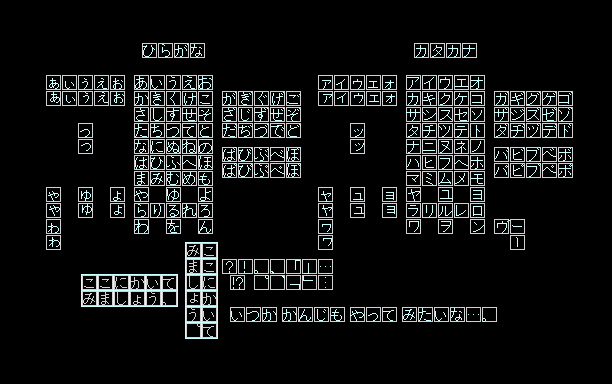Hiragana/Katakana(Japanese Letter) by andy1260

Now we can write japanese on TPT. I hope to make Kanji(Chinese Letter) someday.
letter
japanese
japan
weeabo
anime
roach
m3m3
Comments
-
alice_loona_OT12 14th Oct 2019
 Vowels can also be *long* (lengthened) or short (unlengthened) [the English "ee" is technically "long", but it doesn't matter in EN.]. This is *phonemic*, so it changes meaning. Consonants can also be long, where plosives have longer "closed" periods and *fricatives*, sounds like S, SH, and F, are lengthened as in vowels.
Vowels can also be *long* (lengthened) or short (unlengthened) [the English "ee" is technically "long", but it doesn't matter in EN.]. This is *phonemic*, so it changes meaning. Consonants can also be long, where plosives have longer "closed" periods and *fricatives*, sounds like S, SH, and F, are lengthened as in vowels. -
alice_loona_OT12 14th Oct 2019
 U is like the "oo" in "bOOk", but *unrounded*-- lips spread like in "feet", not rounded like in "poop".
U is like the "oo" in "bOOk", but *unrounded*-- lips spread like in "feet", not rounded like in "poop". -
alice_loona_OT12 14th Oct 2019
 A is like the "o" in "bOt". E is like the Spanish E, roughly similar to the "e" in "bEt". I is like the "ee" in "fEE". IO is like the Spanish O, roughly similar to the O in "boy". This can be approximated in American English by starting to say "oh", but cutting it off before you get to the "low" 'oo-like' point.
A is like the "o" in "bOt". E is like the Spanish E, roughly similar to the "e" in "bEt". I is like the "ee" in "fEE". IO is like the Spanish O, roughly similar to the O in "boy". This can be approximated in American English by starting to say "oh", but cutting it off before you get to the "low" 'oo-like' point. -
alice_loona_OT12 14th Oct 2019
 N at the *START* of a syllable is equal to English. At the END of a syllable, though, it's like the NG in riNG, but further back from the *velum*/softer "G-place"/soft palate //into// an unused-in-English part of the mouth called the *uvula*-- it's a *uvular nasal*.
N at the *START* of a syllable is equal to English. At the END of a syllable, though, it's like the NG in riNG, but further back from the *velum*/softer "G-place"/soft palate //into// an unused-in-English part of the mouth called the *uvula*-- it's a *uvular nasal*. -
alice_loona_OT12 14th Oct 2019
 R is like a short D, e.g. American English "buTTer".
R is like a short D, e.g. American English "buTTer". -
alice_loona_OT12 14th Oct 2019
 T before U is "tsu", like "tsoo". H before U is like "foo", but with both lips instead of bottom lip and top teeth. T before I is like "chee" in cheese [CHI], but also palatalized.
T before U is "tsu", like "tsoo". H before U is like "foo", but with both lips instead of bottom lip and top teeth. T before I is like "chee" in cheese [CHI], but also palatalized. -
alice_loona_OT12 14th Oct 2019
 S before I (vowels explained later) is not pronounced "see", but "she", SH palatalized as below. This is mirrored in the voiced form, which is otherwise like the French J-- English "J"/"soft G" sound without that D at the start.
S before I (vowels explained later) is not pronounced "see", but "she", SH palatalized as below. This is mirrored in the voiced form, which is otherwise like the French J-- English "J"/"soft G" sound without that D at the start. -
alice_loona_OT12 14th Oct 2019
 S, N, H, M, Y, Z, G, D, and B (due to historical reasons, H is seen as voicing to B and "semi-voicing" to P by analogy) are the same as in English.
S, N, H, M, Y, Z, G, D, and B (due to historical reasons, H is seen as voicing to B and "semi-voicing" to P by analogy) are the same as in English. -
alice_loona_OT12 14th Oct 2019
 S voiced to Z (both same as English). P,T,K are *unaspirated*, without any extra air after them (sPin instead of Pin, sKin instead of Kin, sTint instead of Tint)
S voiced to Z (both same as English). P,T,K are *unaspirated*, without any extra air after them (sPin instead of Pin, sKin instead of Kin, sTint instead of Tint) -
alice_loona_OT12 14th Oct 2019
 The voiced version is romanized (written in the ABCDEFGHIJKLMNOPQRSTUVWXYZ alphabet) as J in *Hepburn romanization*, one of the major romanization systems, and the one used here.
The voiced version is romanized (written in the ABCDEFGHIJKLMNOPQRSTUVWXYZ alphabet) as J in *Hepburn romanization*, one of the major romanization systems, and the one used here.